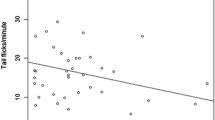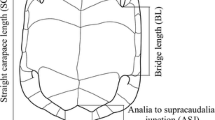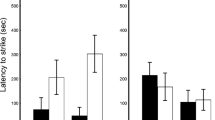Abstract
The decoy or deflection hypothesis, which states that conspicuous colouration is present in non-vital parts of the body to divert attacks from head and trunk, thus increasing survival probability, is a possible explanation for the presence of such colouration in juveniles of non-aposematic species. To test this hypothesis we made plasticine and plaster lizard models of two colour morphs, red or dark-and-light striped tails, based on the colouration of spiny-footed lizard (Acanthodactylus erythrurus) hatchlings, which naturally show a dark-and-light striped dorsal pattern and red tail. Lizard models were placed in the field and also presented to captive common kestrels (Falco tinnunculus), a common avian lizard predator. The number of attacks and the body part attacked (tail or rest-of-body) were recorded, as well as the latency to attack. Our results suggest that models of both colour morphs were recognized as prey and attacked at a similar rate, but in the field, red-tailed models were detected, and thus attacked, sooner than striped-tailed. Despite this increase in detection rate by predators, red-tailed models effectively diverted attacks to the tail from the more vulnerable body parts, thus supporting the decoy hypothesis. Greater fitness benefits of attack diversion to the tail compared to the costs of increased detection rate by predators would explain the evolution and maintenance of red tail colouration in lizards.



Similar content being viewed by others
References
Arnold EN (1984) Evolutionary aspects of tail shedding in lizards and their relatives. J Nat Hist 18:127–169
Arnold EN (1988) Caudal autotomy as a defense. In: Gans C, Huey RB (eds) Biology of the reptilia, vol 16., Ecology B: defense and life historyAlan R. Liss, New York, pp 235–274
Bateman PW, Fleming PA (2009) To cut a long tail short: a review of lizard caudal autotomy studies carried out over the last 20 years. J Zool 277:1–14
Bateman PW, Fleming PA, Rolek B (2014) Bite me: blue tails as a ‘risky-decoy’ defense tactic for lizards. Curr Zool 60:333–337
Bates D, Maechler M, Bolker B (2012) lme4: linear mixed-effects models using S4 classes, R package version 0.999999-0 edn. http://CRAN.R-project.org/package=lme4
Baylis SM, Cassey P, Hauber ME (2012) Capsaicin as a deterrent against introduced mammalian nest predators. Wilson J Ornithol 124:518–524
Belliure J (2006) Lagartija colirroja—Acanthodactylus erythrurus. In: Carrascal LM, Salvador A (eds) Enciclopedia Virtual de los Vertebrados Españoles. Museo Nacional de Ciencias Naturales, Madrid. http://www.vertebradosibericos.org/
BirdLife International (2014) Species factsheet: Falco tinnunculus. http://www.birdlife.org. Accessed Jan 2014
Booth CL (1990) Evolutionary significance of ontogenic colour-cange in animals. Biol J Linn Soc 40:125–163
Bowmaker JK (2008) Evolution of vertebrate visual pigments. Vis Res 48:2022–2041
Brodie ED III (1993) Differential avoidance of coral snake banded patterns by free-ranging avian predators in Costa Rica. Evolution 47:227–235
Burnham KP, Anderson DR (2002) Model selection and multimodel inference: a practical information-theoretic approach, 2nd edn. Springer, New York
Calsbeek R, Cox RM (2012) An experimental test of the role of predators in the maintenance of a genetically based polymorphism. J Evol Biol 25:2091–2101
Carretero MA, Llorente GA (1993) Morphometry in a community of Mediterranean lacertid lizards, and its ecological relationships. Hist Anim 2:77–99
Carrillo J, González-Dávila E (2009) Latitudinal variation in breeding parameters of the common kestrel Falco tinnunculus. Ardeola 56:215–228
Carrillo J, Hernández EC, Nogales M, Delgado G, García R, Ramos T (1994) Geographic variation in the spring diet of Falco tinnunculus L. on the islands of Fuerteventura and El Hierro (Canary Islands). Bonn Zool Beitr 45:39–48
Castilla AM, Labra A (1998) Predation and spatial distribution of the lizard Podarcis hispanica atrata: an experimental approach. Acta Oecol 19:107–114
Castilla AM, Barbadillo LJ, Bauwens D (1992) Annual variation in reproductive traits in the lizard Acanthodactylus erythrurus. Can J Zool 70:395–402
Castilla AM, Gosá A, Galán P, Pérez-Mellado V (1999) Green tails in lizards of the genus Podarcis: do they influence the intensity of predation? Herpetologica 55:530–537
Clark DRJ, Hall RJ (1970) Function of the blue tail coloration of the five-lined skink Eumeces fasciatus. Herpetologica 26:271–274
Cooper WE Jr, Vitt LJ (1985) Blue tails and autotomy: enhancement of predation avoidance in juvenile skinks. Z Tierpsychol 70:265–276
Cooper WE Jr, Vitt LJ (1991) Influence of detectability and ability to escape on natural selection of conspicuous autotomous defenses. Can J Zool 69:757–764
Cuadrado M, Martín J, López P (2001) Camouflage and escape decisions in the common chameleon Chamaeleo chamaeleon. Biol J Linn Soc 72:547–554
Cuervo JJ, Belliure J (2013) Exploring the function of red colouration in female spiny-footed lizards (Acanthodactylus erythrurus): patterns of seasonal colour change. Amphib-Reptil 34:525–538
Darwin C (1871) The descent of man, and selection in relation to sex. D. Appleton and Company, New York
Endler JA (1980) Natural selection on color patterns in Poecilia reticulata. Evolution 34:76–91
Fox SF, McCoy JK (2000) The effects of tail loss on survival, growth, reproduction, and sex ratio of offspring in the lizard Uta stansburiana in the field. Oecologia 122:327–334
Greene H (1988) Antipredator mechanisms in reptiles. In: Gans C, Huey RB (eds) Biology of the reptilia, vol 16., Ecology B: defense and life historyAlan R. Liss, New York, pp 1–152
Haskell DG (1996) Do bright colors at nests incur a cost due to predation? Evol Ecol 10:285–288
Håstad O, Victorsson J, Ödeen A (2005) Differences in color vision make passerines less conspicuous in the eyes of their predators. Proc Natl Acad Sci USA 102:6391–6394
Hawlena D (2009) Colorful tails fade when lizards adopt less risky behaviors. Behav Ecol Sociobiol 64:205–213
Hawlena D, Boochnik R, Abramsky Z, Bouskila A (2006) Blue tail and striped body: why do lizards change their infant costume when growing up? Behav Ecol 17:889–896
Jackson JF, Ingram W III, Campbell HW (1976) The dorsal pigmentation pattern of snakes as an antipredator strategy: a multivariate approach. Am Nat 110:1029–1053
Johnson J, Burt DB, DeWitt TJ (2008) Form, function, and fitness: pathways to survival. Evolution 62:1243–1251
Kemp DJ, Rutowski RL (2011) The role of coloration in mate choice and sexual interactions in butterflies. Adv Study Behav 43:55–92
Kodandaramaiah U, Lindenfors P, Tullberg BS (2013) Deflective and intimidating eyespots: a comparative study of eyespot size and position in butterflies. Ecol Evol 3:4518–4524
Kraus F, Allison A (2009) A remarkable ontogenetic change in color pattern in a new species of Oreophryne (Anura: Microhylidae) from Papua New Guinea. Copeia 2009:690–697
Lancaster LT, McAdam AG, Wingfield JC, Sinervo BR (2007) Adaptive social and maternal induction of antipredator dorsal patterns in a lizard with alternative social strategies. Ecol Lett 10:798–808
Martín J, López P (1990) Amphibians and reptiles as prey of birds in Southwestern Europe. Smithson Herpetol Inf Serv 82:1–43
Mochida K (2011) Combination of local selection pressures drives diversity in aposematic signals. Evol Ecol 25:1017–1028
Møller AP, Erritzøe J (2010) Why birds eat colourful grit: colour preferences revealed by the colour of gizzard stones. J Evol Biol 23:509–517
Ochi H, Awata S (2009) Resembling the juvenile colour of host cichlid facilitates access of the guest cichlid to host territory. Behaviour 146:741–756
Pianka ER, Vitt LJ (2006) Lizards: windows to the evolution of diversity. University of California Press, Berkeley
Pollo CJ, Pérez-Mellado V (1990) Biología reproductora de tres especies mediterráneas de Lacertidae. Mediterránea, Serie de Estudios Biológicos 12:149–160
R Development Core Team (2013) R: a language and environment for statistical computing. Version 2.15.3. R Foundation for Statistical Computing, Vienna, Austria. http://www.R-project.org/
Rosenblum EB (2006) Convergent evolution and divergent selection: lizards at the White Sands ecotone. Am Nat 167:1–15
Ruiz-Rodríguez M, Avilés JM, Cuervo JJ, Parejo D, Ruano F, Zamora-Muñoz C, Sergio F, López-Jiménez L, Tanferna A, Martín-Vivaldi M (2013) Does avian conspicuous colouration increase or reduce predation risk? Oecologia 173:83–93
Schaefer HM, Levey DJ, Schaefer V, Avery ML (2006) The role of chromatic and achromatic signals for fruit detection by birds. Behav Ecol 17:784–789
Seva Román E (1982) Taxocenosis de lacértidos en un arenal costero alicantino. Ph.D. Thesis, Universidad de Alicante, Alicante
Shepard DB (2007) Habitat but not body shape affects predator attack frequency on lizard models in the Brazilian Cerrado. Herpetologica 63:193–202
Stuart-Fox DM, Moussalli A, Marshall NJ, Owens IPF (2003) Conspicuous males suffer higher predation risk: visual modelling and experimental evidence from lizards. Anim Behav 66:541–550
Telemeco RS, Baird TA, Shine R (2011) Tail waving in a lizard (Bassiana duperreyi) functions to deflect attacks rather than as a pursuit-deterrent signal. Anim Behav 82:369–375
Valkonen J, Niskanen M, Björklund M, Mappes J (2011) Disruption or aposematism? Significance of dorsal zigzag pattern of European vipers. Evol Ecol 25:1047–1063
VanderWerf EA, Freed LA (2003) Elepaio subadult plumages reduce aggression through graded status-signaling, not mimicry. J Field Ornithol 74:406–415
Vanzyl AJ (1994) Comparison of the diet of the common kestrel Falco tinnunculus in South Africa and Europe. Bird Study 41:124–130
Vásquez RA, Ebensperger LA, Bozinovic F (2002) The influence of habitat on travel speed, intermittent locomotion, and vigilance in a diurnal rodent. Behav Ecol 13:182–187
Vervust B, Grbac I, Van Damme R (2007) Differences in morphology, performance and behaviour between recently diverged populations of Podarcis sicula mirror differences in predation pressure. Oikos 116:1343–1352
Vervust B, Van Loy H, Van Damme R (2011) Seeing through the lizard’s trick: do avian predators avoid autotomous tails? Cent Eur J Biol 6:293–299
Vitt LJ, Cooper WE Jr (1986) Tail loss, tail color, and predator escape in Eumeces (Lacertilia: Scincidae): age-specific differences in costs and benefits. Can J Zool 64:583–592
Watson CM, Roelke CE, Pasichnyk PN, Cox CL (2012) The fitness consequences of the autotomous blue tail in lizards: an empirical test of predator response using clay models. Zoology 115:339–344
Wilson BS (1992) Tail injuries increase the risk of mortality in free-living lizards (Uta stansburiana). Oecologia 92:145–152
Acknowledgments
We thank C. Esteban, J. Calatayud, M. Cruz, M. Almarcha and C. Zaragoza for their help in the field study, and the staff of the Santa Faz Wildlife Rehabilitation Centre (Alicante, Spain) for their help in the captivity study. Deborah Fuldauer revised English language usage. These studies were funded by the Spanish Ministry of Education and Science and the European Regional Development Fund (Grant CGL2008-00137/BOS).
Author information
Authors and Affiliations
Corresponding author
Rights and permissions
About this article
Cite this article
Fresnillo, B., Belliure, J. & Cuervo, J.J. Red tails are effective decoys for avian predators. Evol Ecol 29, 123–135 (2015). https://doi.org/10.1007/s10682-014-9739-2
Received:
Accepted:
Published:
Issue Date:
DOI: https://doi.org/10.1007/s10682-014-9739-2




